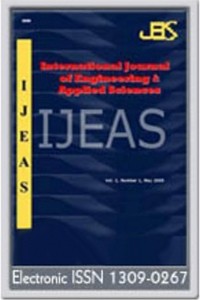NUMERICAL INVESTIGATION OF INSULATION FECT ON SOLAR POND
Solar energy is one of the most important renewable energy sources. Solar heat generation is widely used. Solar pond collects and stores solar energy in the form of heat. Solar pond consists of layers of different density from top to bottom. Salt gradient in the solar pond prevents heat loss by convection in this structure. As well as the heat losses from side and bottom walls are very important to minimize heat losses. In this study, insulated and non-insulated solar ponds were modeled at the same dimensions and summer months. The temperature distributions of the solar pond were obtained during three months (e.g. June, July, August). Furthermore, the temperature distributions were compared for insulated and non-insulated solar ponds. According to calculations, insulated solar pond was found to be much more efficient
Keywords:
Solar energy, solar pond, temperature distribution,
___
- [1] Saylan, L., Sen, O., Toros, H., Arisoy, A., Solar energy potential for heating and cooling systems in big cities of Turkey. Energy Conversion and Management, 43, 1829–1837, 2002.
- [2] Kalogirou, S.A., Solar Energy Engineering Processes and Systems, 1st Edition. Cyprus University of Technology ISBN 13:978-0-12-374501-9, 2009
- [3] Dincer, I., Rosen, M.A., Thermal Energy Storage Systems and Applications, second ed. Wiley, New York, 2011.
- [4] Bozkurt, I., Karakilcik, M., The daily performance of a solar pond integrated with solar collectors. Solar Energy, 86, 1611-1620, 2012.
- [5] Bozkurt, I., Karakilcik, M., Dincer, I., Atiz, A., Transparent covers effect on the performance of a cylindrical solar pond. International Journal of Green Energy, 11, 404–416, 2014.
- [6] Bozkurt, I., Karakilcik, M., Dincer, I., Energy efficiency assessment of integrated and nonintegrated solar ponds. International Journal of Low-Carbon Technologies, 9, 45–51, 2014.
- [7] Karakilcik, M., Dincer, I., Bozkurt, I., Atiz, A., Performance assessment of a solar pond with and without shading effect. Energy Conversion and Management, 65, 98–107, 2013.
- [8] Ranjan, K.R., Kaushik, S.C., Thermodynamic and economic feasibility of solar ponds for various thermal applications: A comprehensive review. Renewable and Sustainable Energy Reviews, 32, 123–139, 2014.
- [9] Kurt, H., Ozkaymak, M., Binark, A.K., Experimental and numerical analysis of sodium-carbonate salt gradient solar-pond performance under simulated solar-radiation. Applied Energy, 83, 324–342, 2006.
- [10] Karakilcik, M., Kıymac, K. and Dincer, I., Experimental and theoretical temperature distributions in a solar pond. International Journal of Heat and Mass Transfer, 49, 825–835, 2006.
- [11] Kayali, R., Bozdemir, S., Kiymac, K., A rectangular solar pond model incorporating empirical functions for air and soil temperatures. Solar Energy, 63, 345–353, 1998.
- [12] COMSOL Heat Transfer Module Users Guide. http://www.comsol.com. 2015.
- [13] Bozkurt, I., Sogukpinar, H., Karakilcik, M., Modeling of a solar pond for different insulation materials to calculate temperature distribution. Journal of Multidisciplinary Engineering Science and Technology, Vol. 2 Issue 6, 1378-1382, 2015
- Başlangıç: 2009
- Yayıncı: Akdeniz Üniversitesi
Sayıdaki Diğer Makaleler
I. Bozkurt, H. Sogukpinar, M. Karakilcik, H. Turkmenler, M. Pala
Turan ÇAKIL, H. Feza CARLAK, Şükrü ÖZEN
